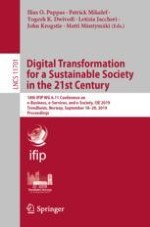2019 | Buch
Digital Transformation for a Sustainable Society in the 21st Century
18th IFIP WG 6.11 Conference on e-Business, e-Services, and e-Society, I3E 2019, Trondheim, Norway, September 18–20, 2019, Proceedings
herausgegeben von: Dr. Ilias O. Pappas, Prof. Dr. Patrick Mikalef, Prof. Yogesh K. Dwivedi, Letizia Jaccheri, Prof. John Krogstie, Matti Mäntymäki
Verlag: Springer International Publishing
Buchreihe : Lecture Notes in Computer Science
